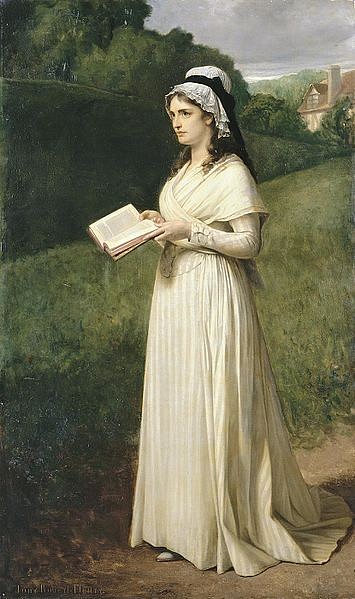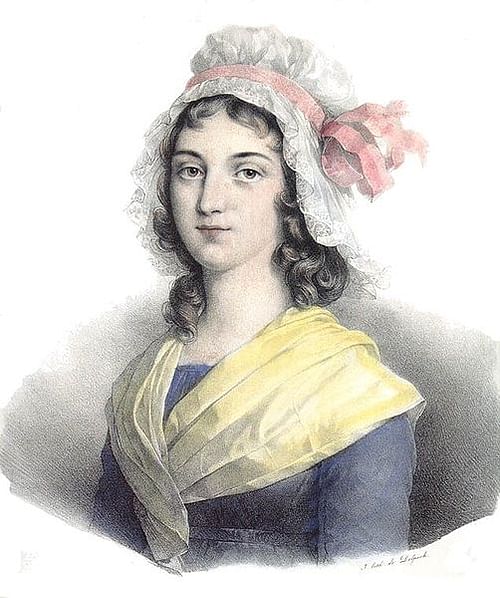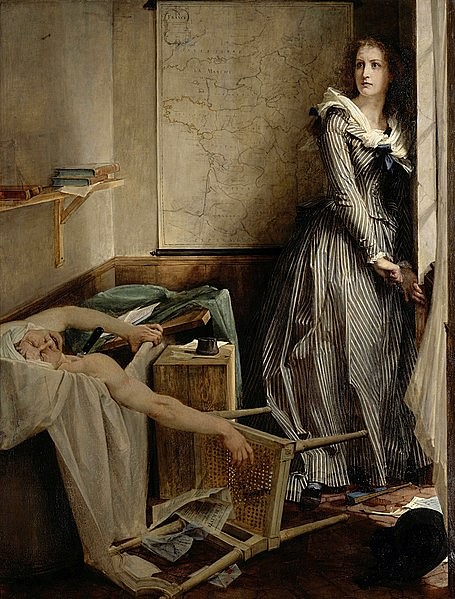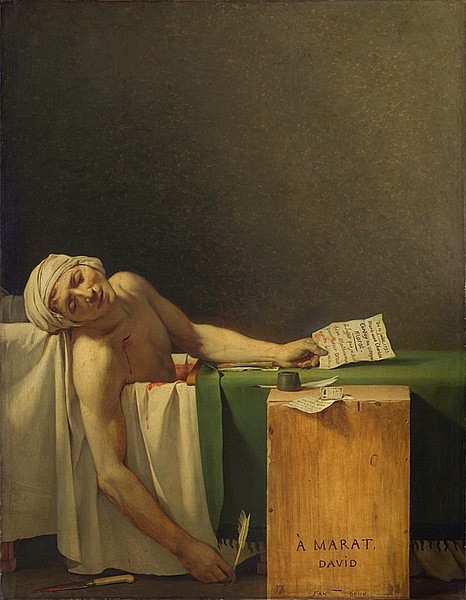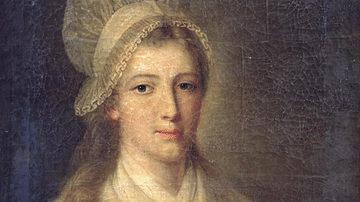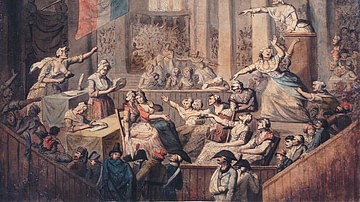
Charlotte Corday (1768-1793) played a prominent role in the French Revolution (1789-1799) when she assassinated radical activist Jean-Paul Marat in his bathtub on 13 July 1793. Despite her aristocratic background, Corday was an avowed republican who believed Marat and his Jacobin allies were corrupting the soul of the Revolution. Following her execution on 17 July, she became a revolutionary martyr.
Corday's assassination of Marat was important, not only as a protest against the bloodshed of the Reign of Terror but also as an instance of women affecting the course of the Revolution. Through her acts, Corday was able to challenge the common perception of women as inherently apolitical. In the centuries since her execution, Corday has been romanticized in poems, art, and literature; in 1847, writer Alphonse de Lamartine assigned her the nickname 'Angel of Assassination'.
Early Years
The assassin known to history as Charlotte Corday was born Marie-Anne-Charlotte Corday d'Armont on 27 July 1768 in Saint-Saturnin, Normandy. Her father, Jacques-François de Corday d'Armont, was the younger son of an impoverished noble family, a descendent of celebrated French dramatist Pierre Corneille. He married the charming but equally destitute noblewoman Charlotte-Marie Gaultier des Authieux, with whom he had five children. Their fourth child was Charlotte, called Marie by close family and friends. Charlotte's childhood was relatively unremarkable, until April 1782, when her mother and eldest sister both died. Grief-stricken and unable to provide for his children, François Corday decided to send 13-year-old Charlotte and her surviving sister, Eleonore, to live in Abbaye-aux-Dames, a convent in Caen, Normandy.
In Caen, Corday was provided with an excellent education by the nuns. Initially a shy and awkward girl, Corday was taught to be well-mannered and refined, eventually exuding an easy elegance befitting her aristocratic background. She was noted for her talents at drawing and singing, and for her striking physical appearance; standing just above five feet tall, she was slender with soft gray eyes, a high forehead, and a dimpled chin. Her hair was light brown and curling, a trait that would later be disputed because of Hauer's famous portrait which depicts her as blond. Corday was also naturally intelligent and studious and could often be found in the convent library engrossed in Greek and Roman histories.
Yet, as Corday grew older, she became increasingly aware of the heightened political tensions that had risen in France. Setting aside her histories, she began reading the works of Jean-Jacques Rousseau and Voltaire, the Enlightenment philosophers who had become so popular across France. She became intrigued by their ideas such as natural rights, the social contract, and the separation of powers. When the Revolution began in May 1789, Corday would have marveled at its rapid reforms, and likely waited anxiously for news to come out of Versailles and Paris. As a self-avowed republican, Corday would have cheered the Revolution's early accomplishments, such as the August Decrees and the Declaration of the Rights of Man and of the Citizen.
Her support for the Revolution put her at odds with her family. Both of her brothers left France for Koblenz to join the royalist French émigré army that was mustering there. On the night before her youngest brother was set to leave, her family held a farewell dinner in which a toast was made to King Louis XVI of France (r. 1774-1792). Charlotte alone did not stand for the toast. When her father asked why she refused to drink to the health of their "good and virtuous" king, she responded, "I believe he is virtuous, but a weak king cannot be a good king. He is powerless to prevent the misfortunes of his people" (Van Alstine, 45). This caused an awkward silence for the rest of the dinner. Later, when asked outright if she was a republican, Corday answered, "I should be, if the French were worthy of a Republic" (Van Alstine, 43). This occasion was an exception, however, as Corday usually abstained from talking about politics for fear of upsetting her family.
To Save a Revolution
In July 1790, the revolutionary National Assembly ordered all convents and monasteries in France to be closed, casting Corday out of the place where she had lived for eight years. Rather than move back with her father, Corday remained in Caen, moving in with her cousin, Madame de Bretheville on her estate. Despite their political differences, the two became close friends, and Corday was named as her cousin's sole heir.
As Corday continued her life in Caen, the Revolution was becoming increasingly extreme and divisive. By September 1792, the French Revolutionary Wars (1792-1802) were underway, the monarchy had been overthrown and the First French Republic established. Such swift societal change inevitably led to intense disagreements about the future of the infant Republic, which was apparent in the bitter rivalry between the Girondin and Jacobin factions. The Girondins had dominated revolutionary politics since October 1791 but were now taking a more moderate stance in the face of the radical populism encouraged by the Jacobins. The Girondins were worried that too much of the Revolution's fate was being dictated by Paris mobs at the expense of the rest of France and advocated for reining in the Revolution. By contrast, the Jacobins championed the desires of the Parisian lower classes and wished to expand the Revolution in even more extreme directions.
Like many others in the French departments, Corday found herself siding with the Girondins. She was sickened by the mob violence encouraged by Jacobin activists, such as the 1792 September Massacres which saw between 1,100 and 1,400 Parisian prisoners murdered by frenzied crowds. The Jacobins' political violence also affected Corday personally. In April 1793, Jacobin search parties hunted down Abbé Gombault, the counter-revolutionary priest who had administered the last rites to Corday's dying mother. Rooted out of his hiding place, Abbé Gombault was executed on 5 April, the first to be guillotined in Caen. After his death, political violence in Caen became more frequent. Pamphlets attacking the Jacobins and accusing them of instigating violence were widely circulated in the city, and it is likely Corday would have read them.
On 2 June 1793, the most prominent Girondins were purged from the National Convention by the very mobs they had long feared. After their leaders were arrested, the remaining Girondins and their supporters escaped to the French departments where they railed against the Jacobin regime and urged all true patriots to rise up; the cities of Lyon, Marseille, and Bordeaux did rebel, casting off their Jacobin administrations and beginning the Federalist Revolts. Caen also became a bastion for Girondins on the run. Following 2 June, escaped Girondins took up residence in the Hôtel de l'Intendance, which was only a short stroll from the estate where Corday lived with her cousin. Corday certainly would have attended their meetings and been amongst the throngs who stood beneath their balcony, listening to their impassioned speeches. On 7 July, Caen held a military parade as a defiant show of force against the Jacobins, which Corday watched with growing unease.
Corday became convinced that the Jacobins were leading France down a dark and bloody path. If they were not stopped, she wholeheartedly believed that the Revolution would become irrevocably corrupted and untold thousands would die. At some point that summer, Corday decided that the only way to prevent civil war, slaughter, and calamity would be to kill a Jacobin leader. She could have chosen Maximilien Robespierre or Camille Desmoulins, among others, but she ended up targeting Jean-Paul Marat, who she believed was most deserving of death.
A physician prior to the Revolution, Marat had become a prominent revolutionary activist who could often be found at the center of the Revolution's bloodiest moments. His newspaper L'Ami du Peuple ("Friend of the People") had helped instigate the infamous September Massacres, and he had played a central role in the fall of the Girondins, who Corday believed were the true champions of the Revolution. With Marat dead, Corday seemed to believe the worst of Jacobin excesses could be avoided, and the Republic would be saved from collapsing in on itself. By July, Corday had decided to take matters into her own hands. She left her cousin's home on the afternoon of 9 July and headed for Paris.
Angel of Assassination
She arrived in Paris on 11 July, lodging in the Hôtel de la Providence on the rue des Vieux-Augustins. Originally, she had planned to kill Marat in full view of the National Convention to maximize her message, but the resurgence of a skin condition that had been plaguing Marat for two years had confined him to his bathtub in his home on the rue des Cordeliers. Corday was disappointed but figured this would have to do.
At 8 am on 13 July, she walked from her lodgings to the Palais-Royal, which was crowded with outsiders who had arrived in the capital for the Bastille Day celebrations. She purchased a newspaper that reported the Jacobins' demands for the executions of leading Girondins, before buying a black hat decorated with green ribbons which would become famous in the years to come. Her most significant purchase that morning was at a cutler's shop, where she bought a wooden-handled knife with a five-inch blade. Slipping the weapon beneath her dress, she made her way to Marat's residence.
She arrived close to 11.30 and was greeted by Catherine Evrard, sister of Marat's fiancée, Simonne. Catherine turned Corday away, telling her that Marat was too sick to receive visitors. At 7 pm, Corday returned. Her arrival coincided with a delivery of fresh bread and the day's papers, allowing her to slip through the door and head up the stairs. Here she was stopped by Simonne herself, who was suspicious of how determined Corday was to see Marat. When Simonne questioned her, Corday announced that she had news about traitors in Normandy, deliberately raising her voice so Marat would overhear in the next room. As Simonne was about to send her on her way, a voice came from Marat's bathroom: "Let her in." Reluctantly, Simonne led Corday into the room, where Marat lay soaking in his tub, a piece of wood lain across to act as a writing desk.
For 15 minutes, he questioned Corday about the supposed Girondist traitors in Caen. He asked her for their names, and Corday supplied him with a list. "Good," said Marat when she had finished. "In a few days, I will have them all guillotined" (Schama, 736). At these words, Corday struck. Reaching into her dress, she drew her knife which she plunged into Marat's right side, just beneath the clavicle. The activist cried out in pain, shouting, "Help me, my beloved!" But by the time Simonne raced into the room, Marat was unresponsive, his bathwater turned a sickening shade of red.
Simonne shrieked. "My God," she cried, "he has been assassinated!" (Schama, 737). As the bathroom window had been kept open, the commotion drew others into the room. The first to enter was Laurent Bas, who worked for Marat delivering his newspapers. Horrified, Bas grabbed a chair and hurled it at Corday before leaping on top of her. He kept her pinned down as Marat's neighbors filtered into the room. Two of them, a dentist and a surgeon, lifted Marat's body from the tub and attempted to stop the bleeding. It was no use; the Friend of the People was dead.
Within an hour, news of the assassination of Marat had spread, and a crowd formed outside the apartment. A committee of six deputies from the National Convention soon arrived to interrogate the assassin. They found her still sitting in Marat's apartment, guarded by the neighbors who had apprehended her, having made no attempt to resist or escape. She answered every question she was asked, informing the deputies that she had come to Paris with the sole intention of killing Marat and that she had acted alone. On this last point, the deputies did not believe her; surely, she was the pawn of some greater conspiracy. They ordered her taken to the Abbaye prison, where she spent the night on a straw mattress, her only companion a black cat. Ironically, the prison in which she was confined was the first site of the September Massacres; the cell she was given had previously housed Jacques-Pierre Brissot and Madame Roland, two of her Girondin heroes.
Revolutionary Martyr
Marat's death sent shockwaves throughout Paris. Almost as shocking as the assassination itself was the fact that it was committed by a woman. While there could be no question of Corday's guilt, it was widely believed at the time that women were biologically incapable of committing such acts on their own. Many were certain that a man had coerced Corday into killing Marat. The Jacobins did much to push this narrative, hoping to get Corday to admit to a wider Girondin conspiracy. To this end, they had her cross-examined three separate times before the Revolutionary Tribunal. In two of these, she was questioned by the Tribunal's president, Montané, who did his best to uncover such a conspiracy.
He would have no such luck. Each time, Corday proudly insisted that she had acted alone. When asked why she had killed Marat, she responded, "I knew that he was perverting France. I have killed one man to save a hundred thousand…I was a republican before the Revolution and I have never lacked energy" (Andress, 189). Montané then asked who counselled Corday to commit the murder, to which she replied:
Corday: I would never have committed such an attack on the advice of others. I alone conceived this plan and executed it.
Montané: But how are we supposed to believe you were not advised to do this when you tell us that you regard Marat as the cause of all evils in France, he who never ceased to unmask traitors and conspirators?
Corday: It's only in Paris that people see him that way. In the other departments, he is seen as a monster.
Montané: How could you regard Marat as a monster when he only allowed you access to him through an act of humanity because you had written to him that you were persecuted?
Corday: What difference does it make that he showed himself human towards me if he was a monster toward others?
Montané: Do you think you have killed all the Marats?
Corday: With this one dead, the rest, perhaps, will tremble. (Schama, 739)
Having freely admitted her guilt and maintained that she had acted alone, Corday's trial was a short one. She was defended by Claude François Chauveau-Lagarde, who would go on to defend Marie Antoinette, though the outcome was never in doubt. Charlotte Corday was condemned to die by guillotine on 17 July. As the verdict was being announced, Corday noticed that an officer of the National Guard was making a sketch of her. Intrigued by this, Corday asked the court if she could be allowed to have a portrait made of her before her death. Once this was granted, she asked the officer, Jean-Jacques Hauer, to turn his sketch into a painting.
For two of her final hours, Corday sat with Hauer in the Conciergerie, making comments on the portrait that would become famous and help cement her status as a martyr. Before it was finished, the pair were interrupted by the executioner, Charles-Henri Sanson, who had come to take Corday away. As she got up to go, she cut off a lock of her hair and gave it to Hauer, a token of her appreciation. Dressed in a red shirt to denote her treason, Corday was loaded in a tumbril, refusing both a seat and a confessor. As it traveled down the streets of Paris, a sudden summer storm broke out, soaking the assassin and giving her an ethereal, almost angelic appearance. "For eight days," wrote one observer who had watched her go by, "I was in love with Charlotte Corday" (Schama, 741).
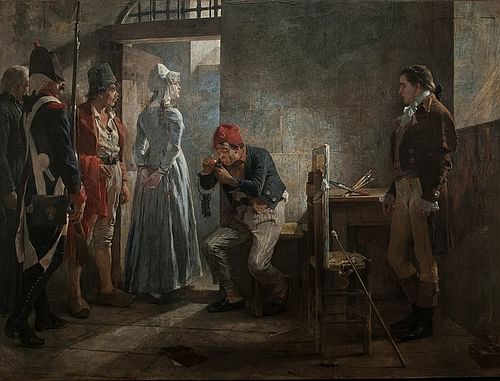
Charlotte Corday was executed by guillotine on 17 July 1793, ten days before her 25th birthday. After she was beheaded, an executioner's assistant grabbed the severed head and slapped it on the cheek. According to legend, the head blushed under the assistant's slap, a tale that has long been used as evidence for those who believe humans retain consciousness for some time after being decapitated. After she was dead, the Jacobins ordered an autopsy to see if she was a virgin, still convinced that she had acted on the orders of a man, perhaps a lover. It was reported that upon her death she was indeed a virgin.
The legacy of Corday is a mixed one. By killing Marat, she inadvertently gave the Jacobins a martyr; by dying for the Girondin cause, she became one herself. Far from saving France from civil war and the Reign of Terror, the slaughter would only worsen after the assassination. Moreover, she failed to win the support of revolutionary women, who were generally appalled by the act. In fact, it is thought that Corday's act contributed to the decision to guillotine prominent female revolutionaries like Madame Roland and Olympe de Gouges. Yet Corday did change the perception of women during the Revolution regarding personal agency and the ability to act on one's beliefs. For this reason, some contemporary feminists who did not condemn her act viewed her as a heroine. In the centuries since her death, Corday has been mythicized in various paintings, poems, and literature, allowing her to live on as a popular figure in French history.

